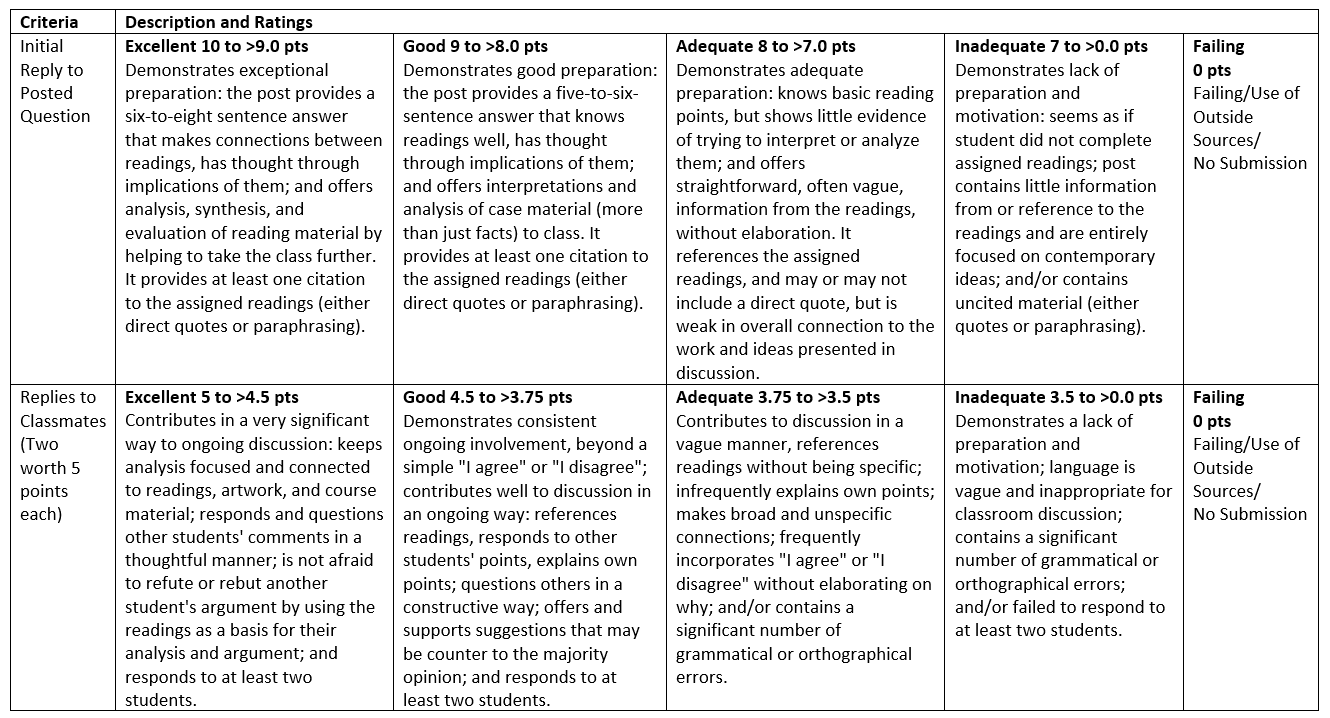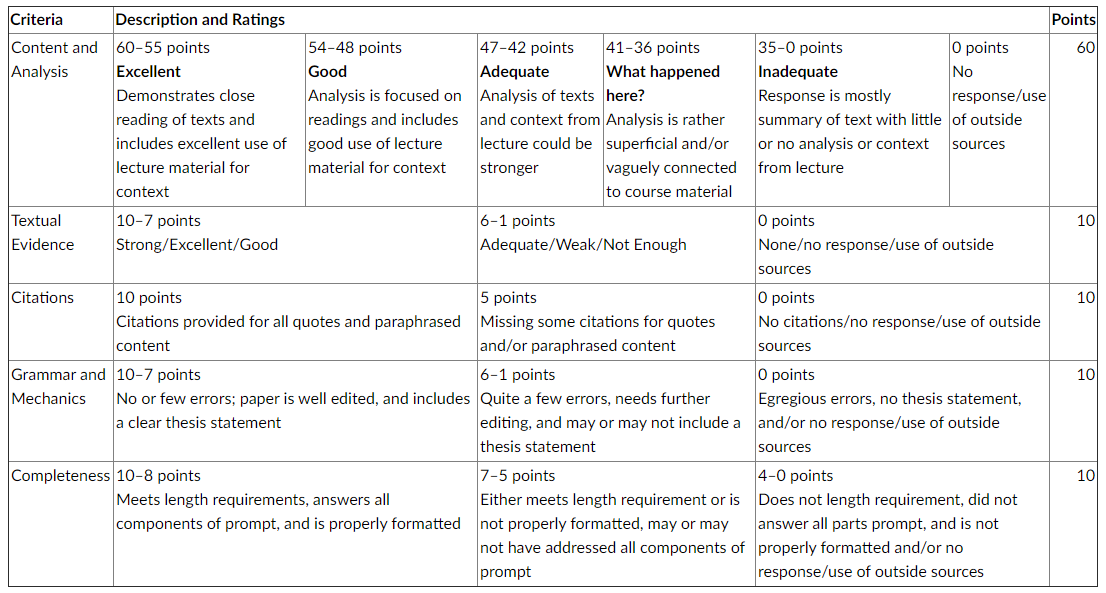Grading rubric strategies
A rubric is an evaluation tool that identifies criteria relevant to an assignment and describes levels of performance expectations for the assignment or other student work. Grading rubrics communicate expectations and help assess the extent to which students are achieving developmental learning outcomes. There are many types of rubrics and most are organized into a table for ease of communication and the purpose of building them into WebCampus.
Benefits
Rubrics are beneficial to both the instructors and the students for the following reasons:
- Ease of communication: In WebCampus, a rubric can be integrated with a variety of assessments, such as assignments, discussions, presentations, and group projects. Your students will be able to quickly access a detailed explanation as to why they received the grade they did and how to improve for the next assignment.
- Rubrics convey the assessment standards to students and also reduce the workload in grading. You’ll be doing far less typing/writing if you use a rubric. Rubrics remove the monotony of repeating yourself.
- They help ensure that the assignments are evaluated fairly and consistently.
- Rubrics also provide students with clear learning goals, specific requirements, and acceptable performance standards for each assignment. This means that they help students become more aware and better able to efficiently evaluate their own work. When the assignments are scored with the rubric, students can easily identify and understand what area needs further effort in order to meet the performance standard.
Components of a rubric
At its core, a successful rubric involves three important components:
- Rubric description: The rubric description provides information to students about what aspects of an assignment or project will be assessed and how they will be assessed.
- Criteria: Criteria, often called dimensions, identify the characteristics or components of the task to be rated. For example, a rubric for a presentation could include content, organization, style, communication, use of visual aid, and presentation skills. A rubric for a written assignment or research paper could include argument, evidence, counter-evidence, sources, and citations.
- Levels of achievement: Levels of achievement are often called scale. Scale uses labels to describe how well or poorly a task has been performed by students. For example, you can use excellent, good, needs improvement, and poor; or sophisticated, competent, and not yet competent to set up the assignment scale.
Steps to designing rubrics
To define the purpose of the assignment, consider the following questions as you do so:
- What exactly is the assigned task? Does it break down into a variety of different tasks? Are these tasks equally important? What are the learning objectives for this assignment or task? What do you want students to demonstrate in their completed assignments or performances?
- What might an exemplary student product/performance look like? How might you describe an acceptable student product or performance? How might you describe work that falls below expectations?
- What kind of feedback do you want to give students on their work or performance? Do you want to give them detailed feedback on a variety of criteria? Do you want to give them specific feedback that will help them improve their future work?
In defining the criteria, start by asking what knowledge and skills are required for the assignment/assessment? Make a list of these, group and label them, and eliminate any that are not critical. The list should contain no more than 6–7 criteria, but it need not include that many. You may also want to review the learning objectives for the course, the assignment prompt, existing grading checklists, comments on previous work, past examples of student work, and/or discuss the criteria with colleagues.
After drafting some criteria, consider its effectiveness: Can they be observed and measured? Are they important and essential? Are they distinct from other criteria?
Overall, most rating scales include 3–5 levels: Excellent, Good, Adequate, Inadequate, Fail, etc. You should use the descriptive words with which they are most comfortable, or not at all. Numbers and grade designations of A, B, C, D, F may be preferred over labels or descriptions. Finally, the rubric may be ordered from lowest to highest or highest to lowest.
Write descriptions for each level of the rating scale you came up with. You may do this for each particular criterion of the rubric or provide information in a more holistic fashion. These descriptions help students understand your expectations.
Well-written descriptions describe observable and measurable behavior, parallel language across the scale, indicate the degree to which the standards are met, and allow the rubric to be used with all assignments for which the rubric was created.
After working hard on designing your rubrics, you should build them within WebCampus. Once you create a Rubric in WebCampus, it will be available for student viewing on the same page as the assignment description. Students can use this as they prepare the assignment, making sure they address each of the areas you note. When it’s time for grading, the same rubric will appear in the SpeedGrader, where you can click on the rating the student earned for each category, and provide comments-per-category if you’d like. When you are finished, the Rubric tool will auto-calculate the total for you. See below for more information on how the Rubrics tool in WebCampus.
WebCampus tool: Rubrics
Learn how to create and manage rubrics in your WebCampus course.
Please see the Canvas Guide: How do I use a rubric to grade submissions in SpeedGrader? For more information.
Sample rubrics
Discussion
Here is a sample of a rubric designed for online discussion:

Essay
Here is a sample of what a rubric designed for an essay and provided in an assignment or syllabus:

Feedback with rubrics
Creating rubrics in WebCampus will take some time at the beginning but this is time well-spent. For instructors, rubrics can be reused over time and can help you to grade more efficiently and with greater consistency. For students, rubrics are beneficial because they can receive more timely and meaningful feedback from instructors and they can develop their self-regulated learning skills as they apply the feedback to their work (Stephens & Levi, 2013).
As you create rubrics, consider the following suggestions:
- Involve students in rubric construction. Stephen and Levi point out the benefits of this approach in that it prevents misunderstanding of expectations and increases students’ awareness of themselves as "stakeholders" in the learning process.
- Use pre-existing rubrics if they exist, and modify them as needed. You can find respected sources of rubrics such as the AACU Value Rubrics (registration required). You may also ask your colleagues about rubrics they use or work with them to create rubrics you share across classes.
References
Rippé, C. (2009, August 31). Using Rubrics to Improve Online Teaching, Learning, and Retention. Faculty Focus.
Stephens, D.D., & Levi, A.J. (2013). Introduction to rubrics (2nd Ed.). Serling, VA: Stylus Publishing, LLC.